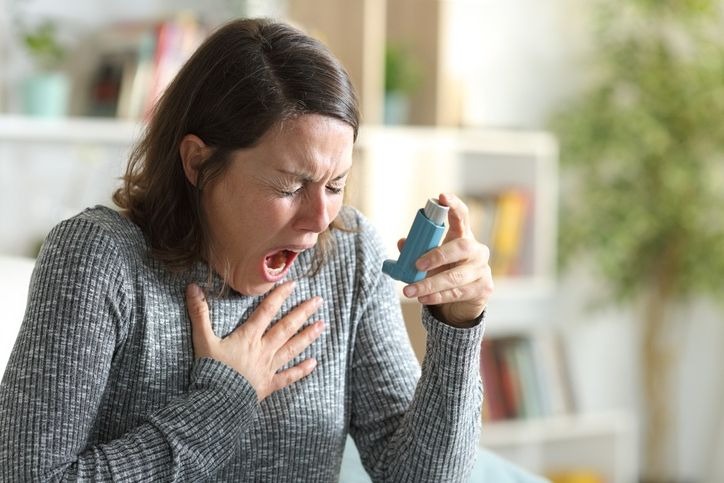Asthma : how to breathe when your bronchi are blocked ?
Caution : You must consult your doctor for your health. This page presents only a personal and alternative point of view which should not be considered as an attempt to prescribe medicine.
Asthma is a chronic respiratory disease that is prevalent worldwide in children and adults.
Asthma is caused by inflammation of the bronchi following exposure to a trigger.
Studies have shown that breathing control can be of great benefit to patients.

However, this must be done in accordance with certain techniques.
Let's see this in detail.
Breathing according to the Buteyko method
This breathing practice owes its name to its creator, Dr. Buteyko, who designed this breathing method in the 1960s.
According to him, asthma attacks originate from hyperventilation of the body.
He explains that the body does not function only thanks to the oxygen (O²), but that the carbon dioxide (CO²) is also beneficial to it.
This gas performs vital functions in the body.
Thus, in the event of a lack of CO² caused most of the time by hyperventilation, the body triggers a defense mechanism.
This mechanism is the blockage of the bronchi … and therefore asthma.
Fortunately, in his analyzes, Dr. Buteyko discovered a method of breathing to overcome asthma attacks or asthmatic coughs.
This consists of moderating the respiratory flow to calm episodes of respiratory blockage.
To start, sit down with your back straight and take your pulse.
Measure the number of beats for 15 seconds and multiply by 4 to know your heart rate over one minute.
Write down your frequency on a piece of paper before you start the exercise.
Then, for a first phase, you have to inhale gently for 2 seconds and exhale in 3 seconds.
After that, you have to cut your breath by pinching your nose and start by counting.
Stop the action when you start to run out of air and note the elapsed time.
This phase is called the control pause which will let you know if you are hyperventilating.
A normal person can hold their breath for about 40 seconds.
A person who hyperventilate has a score of less than 40 seconds, and a breathing master who can control their breath at will gets a score of more than 40 seconds.
The next step is to have shallow breathing for 5 minutes.
This requires maintaining the same posture by breathing very slowly and keeping the chest muscles relaxed.
You should also use the abdomen to control your breath throughout the practice.
It is actually about breathing as little as possible, without creating muscle tension!
In a few sessions, you can get used to this technique.
It will become part of your daily behavior.
After a while, or 5 minutes after your exercise, you can take a monitoring break again to see how much progress you have made.
Breath retention time should be longer than the previous one.
Then, you will have to take a final pulse to compare the result obtained with the first.
You will notice that the latter will be slower than in the first phase.
If your heart rate is higher, you've strained too much!
After a few months of regular practice, patients show a marked improvement in their respiratory rate.
The Buteyko method is very famous in eastern countries because it is very effective in treating acute asthma (with cough) or chronic asthma.
The Papworth method
Extensive research into the disease has shown the effectiveness of this method of breathing in calming her.
The exercise consists of having a breath which essentially involves the use of the diaphragm and the nose.
It prevents the phenomenon of hyperventilation which worsens the symptoms of the disease, by limiting the supply of oxygen.
These are very easy breathing exercises to practice daily in combination with other activities.
To apply this anti-asthma method, you must adopt a good posture with your back straight.
Then take a deep, slow breath for 4 seconds through your nose.
If you take air through your mouth because your nose is blocked for example (or during an asthma attack), do it methodically by creating a small space between the lips, as if you are sucking air through a straw. .
As for your exhalation, it should be done only through your nose and a little slower than inhalation.
When exercising, you should put all of your attention on your diaphragm.
Use your abdomen (abdominal muscles) to control the flow of the breath while listening to the sound of the breath.
It is for this reason that you should practice this method in a quiet place.
This will restore your breathing rhythm and eliminate the hyperventilation that causes asthma attacks.
And finally, there is a technique employed by yoga practitioners to overcome the problem.
The Yoga Pranayama method
In Yoga, pranayama exercises will be used to regulate the respiratory rate in order to cure asthma attacks.
We can present 3 breathing techniques:
- Ujjayi which consists in practicing inspiration and expiration while limiting the arrival of air in the glottis. The goal is to breathe less oxygen to increase the CO2 concentration.
- The Nadhi Shodana or alternate breathing, use the thumb and ring finger to alternate breathing through the nostrils.
- Shitali by which one must inhale through the mouth with the tongue rolled into a tube shape and exhale through the nose. I am less adept of this technique because I prefer to avoid any mouth breathing.
Here then, each of these methods of breathing makes it possible to reduce the drug treatment of asthma, in particular the ventoline to dilate the bronchi.
However, if anti-asthma breathing exercises are not enough, you should always refer to the advice of a doctor for safety.
❤ The ultimate guide to breathing
Intermittent Breathing : Discover the method to quickly relieve your anxiety and chronic fatigue (positive effects from the first use).Read also :
Previous article : How to breathe to reprogram your brain ?
Next article : Sleep apnea : how to breathe better at night?

